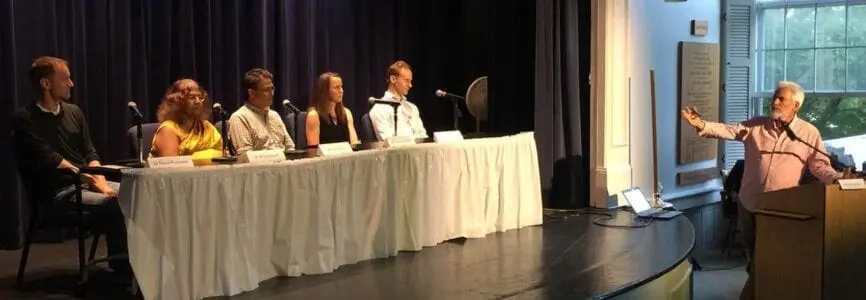Hastings Center News
Should Gene-Edited Mice Be Released to Control Lyme Disease?
Hastings Center research scholar Carolyn P. Neuhaus participated in a panel discussion on Martha’s Vineyard on July 12 to discuss a proposal to release genetically modified mice to curb the spread of Lyme disease and other tick-borne illnesses. A Netflix film crew recorded the event, which featured Kevin Esvelt, an evolutionary biologist at MIT. Michael Specter, a staff writer for The New Yorker, was the moderator.
Esvelt is working with residents of Martha’s Vineyard and Nantucket to develop Mice Against Ticks, a project that aims to reduce the incidence of tick-borne diseases by breaking the transmission cycle among white-footed mice, deer ticks, and the pathogens that they carry. Ticks that bite infected mice transmit pathogens to other mice and to humans. Mice Against Ticks proposes to use CRISPR gene editing on mice in an attempt to inoculate them against the pathogens and then to release the gene-edited mice on Martha’s Vineyard and Nantucket in hope of reducing the spread of tick-borne diseases on these islands, where the incidence is high.
In her remarks, Neuhaus emphasized the importance of the research team meeting with local residents to “crowdsource” relevant information, including “idiosyncrasies of the ecosystem, where certain things are located on the islands, not to mention the specific concerns of residents,” she said. The crowdsourcing process would be a means of public deliberation to help determine whether the experiment should go forward and, if so, to help shape the experimental design. Other panelists included Sheila Jasanoff, a bioethicist at Harvard; Sam Telford, a tick expert at Tufts; and Duane Wesemann, a researcher at Brigham and Women’s Hospital. Read more about the event. Watch the video of the event.
Neuhaus has written extensively about community engagement ahead of field trials of genetically modified insects and animals. Read her articles in the Hastings Center Report and Nature Biotechnology.

